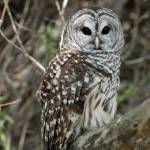Feel the wild side with barred owls
Published 9:50 pm Tuesday, February 18, 2020


|
Getting your Trinity Audio player ready...
|
By Steve Roark
Tri-State Outside
The most common owl that I run across locally is the Barred Owl (Strix varia) but have only seen them a handful of times. But I know they visit my woods regularly by their easy to recognize 8 or 9 note call that is remembered by the phrase “who cooks for you, who cooks for you-all.” When I hear the Barred or any owl call out, it gives me a shiver of wildness that is very satisfying.
Trending
The Barred Owl is easy to identify from other owls of our area. It’s a chunky bodied brown and white bird that lacks the pointy ear tufts of the horned owl and is the only owl with brown eyes (everybody else has yellow ones). The name barred comes from the brown horizonal streaks on its head and upper chest. The face is rather pale and flat, with dark rings encircling the eyes.
The Barred Owls preferred habitat is a mature forest with a clean understory to be able to hunt without dodging brush. Like all owls the Barred is a raptor, with mice and other rodents being a favorite prey. They also feed on other small mammals like squirrel and voles, as well as birds, frogs, and salamanders. While they most often hunt at night, favoring dawn and dusk, they can be found hunting during daylight hours. Their hunting routine involves waiting on a perch for supper to show up, and then swooping down low for the kill, depending on keen hearing good night vision to locate the target prey. Their feathers are designed for quiet flight and added stealth.
Making more Barred Owls starts with a courtship of bobbing and bowing heads and raising wings at each together. Once the deed is done the female makes a nest in a hollow tree or perhaps an old hawk nest. She lays an average of 3 eggs and incubates them for a month. The male brings food for her during this time and continues to do so after the young hatch. They grow rapidly and are ready for first flight in about 6 weeks. Prior to flying, the owlets are able to climb around on the tree by gripping the bark with their talons and bill, which is comical to see.
During the spring breeding season male turkeys are hyped up with hormones and edgy. If they aren’t gobbling on their own, hunters can make jakes “shock gobble” by mimicking a barred owl’s call, and thus figure out their location.
Surprisingly, the most serious predatory threat to Barred Owls is the Great Horned Owl, a slightly larger and more aggressive bird. When the Horned Owls move into an area, the Barred move out. Owls are very effective at keeping rodent populations down, so having them around is cool. They can be encouraged by setting up nesting boxes and plans for them are easy to find online or through your state wildlife agency.








